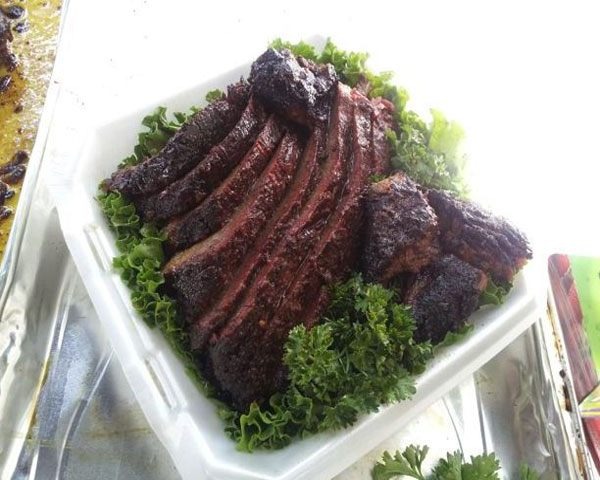The Food Almanac: Tuesday, May 28, 2013
Today's Flavor
This is National Beef Brisket Day. And well it should be. If there were an official start to barbecue season, it would be Memorial Day. And no cut of beef is better suited to barbecue techniques than brisket.
Brisket's qualities lend it to all kinds of slow cooking. Boiled and cut into big cubes, it becomes the heart of vegetable beef soup. Smoked and sliced thin, it's one of the two great subjects for barbecue. Cured ("corned") for a few weeks and then boiled, it's the centerpiece of either St. Patrick's Day or the kosher deli.
The magic of brisket comes from the wispy connective tissues you see between the meat fibers. When you cook it for a long time (four hours seems to be the magic interval), these melt into the lean and make it tender. It also gives the broth you make from the boiling liquid (if you cooked it that way) taste superb.
Brisket comes from the part of the steer that would be its armpit if cows had armpits. Whole briskets give two sections with differing textures. The flat end is best for smoking and barbecue. The butt end works better for boiling, because its grain twists and changes direction relative to your slicing–a real problem when cutting it into anything other than chunks.
The Old Kitchen Sage Sez:
A brisket is like a child. Even when you treat them all the same, they all come out different.
Gourmet Gazetteer
Beef Creek travels southwest for about sixteen miles across rolling Oklahoma farm before emptying into Cache Creek, an intermediary tributary of the Red River. Its last miles crosses Beef Flats on the Fort Sill Military Reservation, eighty-four miles southwest of Oklahoma City. There is no question that a many generations of beef cattle have lived and died in these plains. The nearest restaurant of note outside the military zone is El Greco in Lawton, three miles away on nearby I-44.
Edible Dictionary
hanger steak, n.–A heart-shaped cut of beef taken from behind the ribs, where it literally hangs, attached to no bones. Its purpose is to palpate the pancreas. Its French name, which shows up on some menus, is onglet. It is unusual in being symmetrical with respect to a vertical line through the steak. There's only one hanger steak, weighing a generous pound or so, in each cow. It has been called a "butcher's cut," because its uniqueness and goodness caused butchers to saved it for themselves. Hanger steak is a bit chewy, with a texture similar to that of flank. It's usually pre-sliced in the kitchen, across the grain, before it enters the dining room. The hanger steak has a distinctive flavor, reminiscent of that of an aged steak. They're usually grilled whole over a very hot fire, and cooked rare or medium rare.
Annals Of Soft Drinks
Today in 1985, outraged by New Coke, the Old Cola Drinkers of America was organized. It, and less well organized protests, later forced the re-introduction of Coca-Cola Classic. That original flavor returned to dominance in the United States (but nowhere else).
A New Dish Is Born
Today is the birthday, in 1897, of Jell-O. Pearl B. Wait–a maker of cough syrup–devised the stuff. The original flavors were strawberry, raspberry, lemon and orange. It didn't sell well, so Wait sold the formulas and name to a guy with the great name Orator F. Woodward, who had the advantage of being in the food business already. It took about another seven years, but starting in 1902, Jell-O's sales gelled. There was plenty of room for Jell-O. But when's the last time you ordered it in a restaurant?
Gourmets In Fiction
Ian Fleming, the creator of James Bond in his many novels about the suave superspy, was born today in 1908. Fleming had Bond insisting on the best Champagnes (Bollinger, to be exact) and cocktails made with extreme attention to detail ("three measures of Gordon's, one of vodka, half a measure of Kina Lillet. Shake it very well until it's ice-cold, and then add a large thin slice of lemon-peel. Got it?"). Fleming is to blame for the fact that more martinis are made with vodka instead of the more classic gin. That's what Bond drank. Shaken, not stirred.
Deft Dining Rule #177:
If you really want to call attention to yourself, ask for a martini stirred, not shaken. If questioned, note that when a martini is stirred, less of the ice melts, and the drink packs a more convincing gin (of course, it's gin) punch.
Annals Of Sno-Balls
Today in 2004, Bot and Nola opened in Abita Springs. One of the great sno-ball stands, it uses very finely-shaved ice and a dizzying array of flavors, including one they let us formulate for them to approximate the taste of the old soft drink Dr. Nut. It's named for the owner's grandparents, who used to live next door. ("Bot" was the nickname of her grandfather, Bartholemew.)
Food Namesakes
Clarence "Taffy" Abel, one of the first professional hockey players native to the United States, was born today in 1900. . . Aaron "T-Bone" Walker, blues guitarist, was born today in 1910. . . Pro basketballer Glen Rice was born today in 1967. . . Broadway actress Madeleine Le Roux was born today in 1946. . . Actress Carroll Baker, a classic blonde bombshell, looked cute already when she was born today in 1931.
Words To Eat By
"I take a ridiculous pleasure in what I eat and drink."—James Bond.
Words To Drink By
"The hard part about being a bartender is figuring out who is drunk and who is just stupid."–Richard Braunstein, motivational writer.
